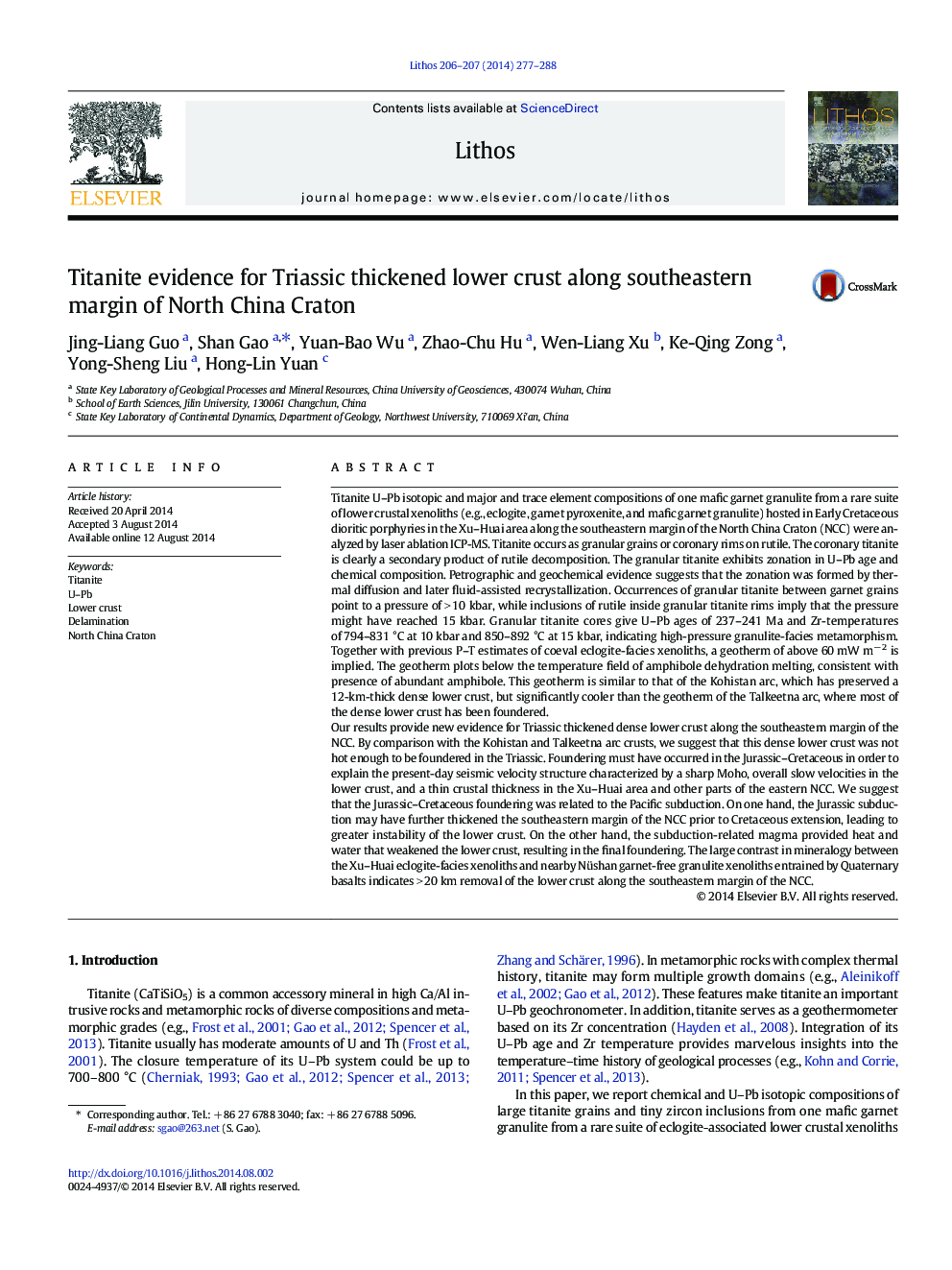| کد مقاله | کد نشریه | سال انتشار | مقاله انگلیسی | نسخه تمام متن |
|---|---|---|---|---|
| 4715952 | 1638672 | 2014 | 12 صفحه PDF | دانلود رایگان |
• Titanite records a high-pressure granulite-facies metamorphism at 237–241 Ma.
• New evidence for a Triassic thickened lower crust along the SE margin of the NCC.
• The thickened lower crust was not hot enough to be foundered in the Triassic.
• This thickened lower crust must have foundered during the Jurassic–Cretaceous.
• > 20 km dense mafic lower crust was removed along the SE margin of the NCC.
Titanite U–Pb isotopic and major and trace element compositions of one mafic garnet granulite from a rare suite of lower crustal xenoliths (e.g., eclogite, garnet pyroxenite, and mafic garnet granulite) hosted in Early Cretaceous dioritic porphyries in the Xu–Huai area along the southeastern margin of the North China Craton (NCC) were analyzed by laser ablation ICP-MS. Titanite occurs as granular grains or coronary rims on rutile. The coronary titanite is clearly a secondary product of rutile decomposition. The granular titanite exhibits zonation in U–Pb age and chemical composition. Petrographic and geochemical evidence suggests that the zonation was formed by thermal diffusion and later fluid-assisted recrystallization. Occurrences of granular titanite between garnet grains point to a pressure of > 10 kbar, while inclusions of rutile inside granular titanite rims imply that the pressure might have reached 15 kbar. Granular titanite cores give U–Pb ages of 237–241 Ma and Zr-temperatures of 794–831 °C at 10 kbar and 850–892 °C at 15 kbar, indicating high-pressure granulite-facies metamorphism. Together with previous P–T estimates of coeval eclogite-facies xenoliths, a geotherm of above 60 mW m− 2 is implied. The geotherm plots below the temperature field of amphibole dehydration melting, consistent with presence of abundant amphibole. This geotherm is similar to that of the Kohistan arc, which has preserved a 12-km-thick dense lower crust, but significantly cooler than the geotherm of the Talkeetna arc, where most of the dense lower crust has been foundered.Our results provide new evidence for Triassic thickened dense lower crust along the southeastern margin of the NCC. By comparison with the Kohistan and Talkeetna arc crusts, we suggest that this dense lower crust was not hot enough to be foundered in the Triassic. Foundering must have occurred in the Jurassic–Cretaceous in order to explain the present-day seismic velocity structure characterized by a sharp Moho, overall slow velocities in the lower crust, and a thin crustal thickness in the Xu–Huai area and other parts of the eastern NCC. We suggest that the Jurassic–Cretaceous foundering was related to the Pacific subduction. On one hand, the Jurassic subduction may have further thickened the southeastern margin of the NCC prior to Cretaceous extension, leading to greater instability of the lower crust. On the other hand, the subduction-related magma provided heat and water that weakened the lower crust, resulting in the final foundering. The large contrast in mineralogy between the Xu–Huai eclogite-facies xenoliths and nearby Nüshan garnet-free granulite xenoliths entrained by Quaternary basalts indicates > 20 km removal of the lower crust along the southeastern margin of the NCC.
Figure optionsDownload as PowerPoint slide
Journal: Lithos - Volumes 206–207, October 2014, Pages 277–288
